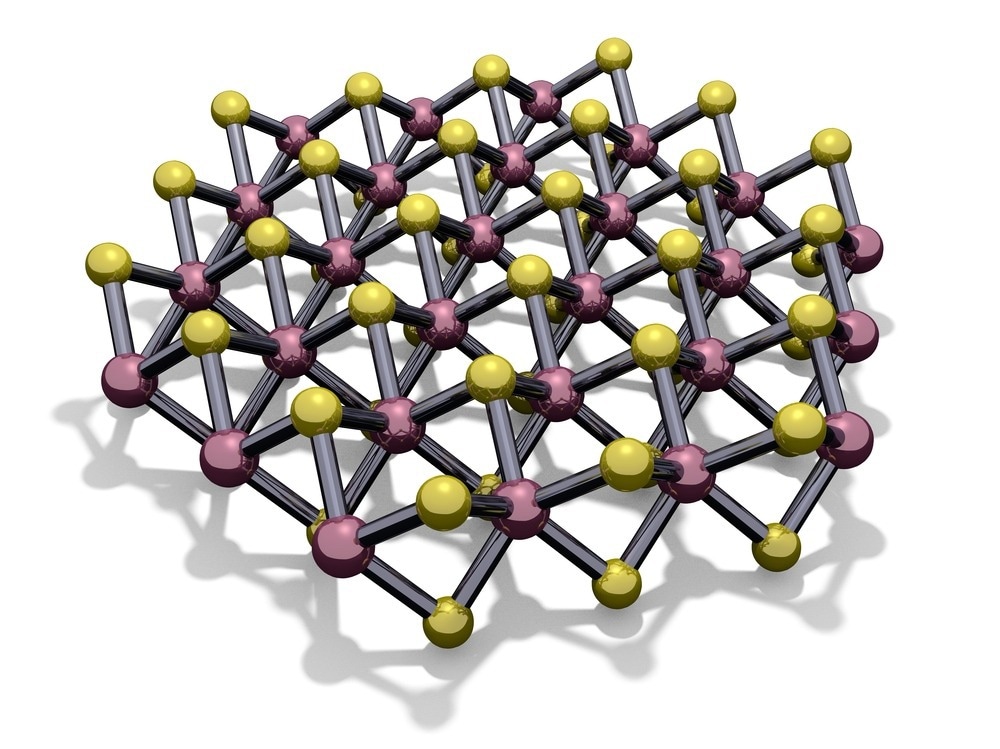Surface-enhanced Raman spectroscopy (SERS) is a powerful analytical tool for analyzing plasmonic-2D materials at hotspots. Moreover, hotspots are critical in SERS because they are the places with intense local electromagnetic (EM) fields and contribute a proportion of the overall SERS intensity.
 Study: Enhancing Raman spectra by coupling plasmons and excitons for large area MoS2 monolayers. Image Credit: ogwen/Shutterstock.com
Study: Enhancing Raman spectra by coupling plasmons and excitons for large area MoS2 monolayers. Image Credit: ogwen/Shutterstock.com
An article published in the journal Applied Surface Science reported Raman signal enhancement by coupling plasmons and excitons between large area monolayered molybdenum sulfide (MoS2) and plasmonic nanogrooves (NGs). Instead of SERS enhancement, the plasmon-exciton coupling enhanced the Raman signal at the excitation wavelength.
Spectrally tunable NGs were utilized to investigate decoupled and coupled enhancements, whose performance was examined by enhancement in the EM field. Thus, the present work demonstrated the potential applications of nanostructure-incorporated atomically thin two-dimensional (2D) materials that showed uniform Raman signals in nanophotonics and material science.
Analytical Techniques to Enhance Raman Signal
Raman Spectroscopy is a non-destructive chemical analysis technique that provides detailed information about chemical structure, polymorphy, crystallinity, and molecular interactions. It is based on the interaction of light with the chemical bonds within a material.
SERS is a sensitive technique that enhances the Raman scattering of molecules supported by some nanostructured materials. Under EM field enhancement, the localized surface plasmons provide “hotspots” that amplify the Raman signals.
Resonance Raman spectroscopy (RRS) is an advanced technique used to study vibrational bands in the group frequency region. The information obtained is similar to that of Fourier transform infrared (FTIR) and Raman studies.
In RRS, when the excitation wavelength coincides with the excitonic transition or is close to the analyte's absorption band, the Raman signal amplifies, increasing sensitivity and selectivity. However, RRS strongly depends on the excitation wavelength, limiting the analytes in Raman spectroscopy.
While SERS yields superior enhancement in signal over conventional Raman techniques, surface-enhanced resonance Raman spectroscopy (SERRS) produces even greater enhancement in chemical signal through the coupling between plasmons and molecular exciton resonance.
When the energy exchange rate (g) in a coupled system is faster than relaxation terms of polaritons and excitons, a strong coupling occurs between polaritons and excitons. The polariton-exciton coupled system requires an energy exchange rate, 2g greater than γ and ĸ (γ and ĸ correspond to emitter scattering rate and cavity loss, respectively) for the energy to cycle between light and matter.
Nanophotonics investigates the behavior of light on nanometer scales and the interactions of nanometer-sized objects with light. Nanophotonics often includes metallic components that can transport and focus light through surface plasmon polaritons.
MoS2 is a 2D material with a layered structure of hexagons that consist of covalently bonded molybdenum (Mo) and sulfur (S) atoms. The superior optical and electronic properties make ultrathin MoS2 attractive for low-power optoelectronic applications.
With the rapid development of various ultrathin MoS2-based devices, the unique property characterization and easy identification methods of atomic thick MoS2 flakes are in high demand. Raman spectroscopy, a powerful non-destructive characterization tool, has been used to study different crystalline structures of MoS2.
Enhancing Raman Spectra by Coupling Plasmons and Excitons
In the present work, molten sodium molybdate (Na2MoO4) was used as a precursor and uniformly distributed on the film via the chemical vapor deposition (CVD) process. The resulting monolayered MoS2 films were used as analytes for quantitatively studying Raman signal enhancement.
While most of the previous works on SERRS dealt with molecules, in the present study, transition-metal dichalcogenide (TMDC) based 2D materials were chosen as sensing targets owing to their atomic thickness and intrinsic homogeneous properties. Thus, large-area MoS2 monolayers were used as templates to quantify the Raman signal enhancement.
When the surface plasmon resonance was tuned across the exciton resonance, characteristic anti-crossing, which indicates a strong or intermediate coupling, can be seen. Moreover, the surface plasmon resonance can be tuned by changing the depth, width, and period of the gold (Au) NGs. Thus, the 2D MoS2 was integrated into one-dimensional (1D) gold (Au) NGs to achieve plasmon-exciton coupling.
Unlike previous studies that focused only on the SERS effect, the plasmonic resonance in the present work was designed to couple with MoS2 excitons instead of the excitation wavelength. Additionally, coupled and decoupled samples were studied to quantitatively analyze the Raman enhancement factors. Thus, through the findings of the present work, plasmon-exciton coupled hotspots were studied, including low-concentration molecules and low-dimensional nanomaterials.
Conclusion
Overall, the 2D material integrated plasmonic NGs offered a robust platform for enhancing the Raman signals. Quantitatively analyzing the enhancement of the Raman signal by 80-folds compared to the signal of MoS2 on planar Au film under the excitation wavelength of 532 nanometers confirmed the enhancement of the EM field induced by exciton-plasmon coupling.
Additionally, factors affecting the enhancement of the EM field were introduced to explain the plasmon-exciton coupling-induced Raman signal enhancement. Furthermore, the sample demonstrated in the present work has great potential in nanophotonics and surface science.
Reference
Yu, M.W et al. (2022). Enhancing Raman spectra by coupling plasmons and excitons for large area MoS2 monolayers. Applied Surface Science. https://www.sciencedirect.com/science/article/pii/S0169433222022954?via%3Dihub
Disclaimer: The views expressed here are those of the author expressed in their private capacity and do not necessarily represent the views of AZoM.com Limited T/A AZoNetwork the owner and operator of this website. This disclaimer forms part of the Terms and conditions of use of this website.